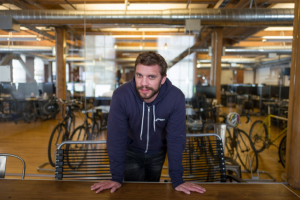Despite the vast difference between grandma sending another questionable Christmas sweater parcel from Minnesota and an order of 500 electric scooters shipping out of Jinhua, Zhejiang in China – people seem to think they’re the same thing. As CEO of Flexport, Ryan Petersen believes the difference is a simple one: the minute grandma sends one hundred sweaters and it becomes too heavy for one man to pick up and put into the truck, it ceases being a parcel delivery.
When that happens, Petersen says “it needs a whole different network to move it. It can’t go through those same trucks, the conveyor belts are too narrow for freight, for pallets.” There is a significant shift in customer experience when shipping freight, he believes, and it’s sometimes hard for the customer to understand.
“[W]hat fundamentally happens that’s different is in the parcel business it’s from end-to-end, one company,” Anderson explained. “And therefore, they can have scanners at each node, at each node in the network, they can give you that nice user experience with the milestones telling you where your stuff is.”
That’s not how it works when moving large quantities of goods, Anderson says. There is no one company in the world big enough to accommodate end-to-end shipment within their own network. Consequently, there is no seamless customer experience with a convenient tracking and updates on shipment status. But Flexport is helping customers fix that with what has been up to this point, a paper driven industry.
Freight forwarding is the circulatory system of global trade, Flexport’s website says, and the company has made it their mission to make the process more transparent, agile and efficient. They offer one place to manage all aspects of supply chain management, from the initial order placed to the final invoice delivered. Their system connects all the disparate parts involved in trade – including importers, exporters, trucking companies, ocean carriers, airlines, customs agencies and port terminals – through a single, secure cloud-based platform.
Their solution to a complex problem hasn’t been missed by the market. In January 2019, Flexport announced that SoftBank’s Vision Fund had made a sizable capital contribution of $1 billion to the tech company – driving their valuation up to $3 billion. They plan on using the cash injection to grow their customer base and take-on tech giant Amazon as they invest heavily in their own global logistics for marketplace sellers.
“Our business is super scale-driven and that’s SoftBank’s entire modus operandi,” Flexport CEO Ryan Petersen said in an interview. SoftBank is out “to drive and inject scale into companies, and help them go faster,” he said, and that’s just what they’re doing. The freight-forwarding company moves goods by plane, train and boat and provides customers with data and insights on saving money, container utilization and emissions, and supply chain tracking. They even support businesses with less-than-full shipping containers – those usually considered lower priority by the big deals in the logistics business.
“We’re in early days,” Michael Ronen, managing partner at SoftBank, said. “Amazon is amazing at what it does, but there is a whole universe of merchants and global trade that is operating outside of Amazon and doesn’t have their scale.” He said that SoftBank’s investment in Flexport “is not so much about going against Amazon, but supporting everyone else that needs a better solution and needs some scale.”
























